
Northern Europe is a mysterious region, known mostly for its harsh climate and sagas about brave Viking warriors. The way of life of the Normans was long a mystery to foreigners, but with the spread of the Swedish furniture chain IKEA around the world, interest in their unpretentious lifestyle flared up. With its simplicity and airiness, the Scandinavian style instantly gained huge popularity among designers and became one of the most relevant directions in apartment design. The basic characteristics and photos of such interiors are presented in this article.
Features of the Style
Even one glance at any traditional interior is enough to determine in which region it was created. When furnishing a home, people, one way or another, repeat the landscapes, shades, and lines that surround their homes from the outside. Perhaps that’s why every detail of Nordic design so resembles the Scandinavian Peninsula with its rocky fractures, icy fjords, and snow-covered shores.
The color palette here is limited to winter shades – white, gray, dusty blue occupy almost all space. Only in modest decor, furniture, and textiles are splashes of bright colors possible. As a rule, they are present on traditional carpets and embroidered patterns – these are red, burgundy, orange, blue, and ocher-yellow threads with a natural gray admixture.
Natural materials dominate in Scandinavian design, with wood playing a leading role. Its living texture somewhat dilutes the severity of the achromatic setting, giving the rooms a cozier look. In modern interpretation, untreated boards are mainly used for floor finishing, while furniture is more often covered with snow-white enamel or laminated with glossy white film.
Standard for Northern European interiors, wall and ceiling decoration are perfectly smooth and clean whitewashing (painting) in snow-white or gray color, less often – white brick masonry, gray-blue wallpaper with geometric print, or light wooden panels. Whitened beams may occasionally be present on the ceiling, for example, if it is a country house, attic, or high room of unusual layout.
Special attention should be paid to windows. Due to the short daylight hours and lack of sun, Scandinavians almost never cover them with either curtains or even light drapes. However, for those who still need privacy in the evening-night time, you can use opaque tulle or dense monochrome gray curtains. The window openings themselves are usually quite large, and the frames with thin partitions are painted white.


Regardless of the area, a Scandinavian-style living room is always something spacious, light, and filled with air. Snow-white finish, warm wooden floor, comfortable furniture, and quality textiles give even the smallest room a fresh and well-groomed look.
Durable fabrics made of wool, cotton, and linen, sometimes with a small admixture of synthetics, are used for upholstering the sofa and soft chairs. This can be dense jacquard with diamond and triangular patterns, weaving reminiscent of burlap, different furry and velvety textures – velour, velvet, velveteen.
Given the cold climate, a carpet is often laid next to the sofa. The most appropriate are monochrome options with fluffy medium-height pile (imitating the skins of northern animals), as well as woven products with ethnic Scandinavian ornament. Bright decorative pillows, chunky knit throws, and other “warm” hand-made items will also be useful.




A Scandinavian-style kitchen exudes cleanliness and coolness. Everywhere there are perfectly smooth surfaces, facades sparkling with snow-white lacquer, stone countertops, mirror-like steel of appliances and accessories, brickwork or patchwork tiles on the apron.
Warm shades are added to the winter-strict interior by light parquet or ceramic granite on the floor that imitates its texture, wooden table, stools, hanging shelves. To avoid freezing during cooking, a woven rug is often laid on the floor in a narrow kitchen, and in the dining area – a small carpet with characteristic patterns.
The maximum bright light in the Scandinavian kitchen is provided by an uncurtained window and numerous bulbs that hang everywhere without shades. For apartments in megacities where the sun rarely peeks in, this is really a great idea.



The characteristic spaciousness and openness of the Nordic interior is also reflected in the bedroom. White walls, glossy wardrobe of the same color (or gray, like a rock), a simple bed with a low headboard and the complete absence of any excesses – the optimal option for those who put comfort and practicality first.
The atmosphere in this restrained achromatic bedroom is created by details – whitewashed boards and a furry carpet on the floor, light curtains falling in vertical folds, several thematic pictures in frames, fresh bed linen, soft woolen blankets, lots of pillows.
As a decor and at the same time romantic evening lighting for a bedroom in the Scandinavian style, electric garlands with large bulbs can be used, hung on the walls. The preference should be given to the shade of “warm white” – so the room will look cozier and softer than with cold or colored lighting.



Regardless of the size, a living room in Scandinavian style is always something spacious, bright, and filled with air. A snowy finish, warm wooden floor, comfortable furniture, and quality textiles give even the smallest room a fresh and well-groomed look.
For upholstering sofas and soft armchairs, durable fabrics made of wool, cotton, and flax are used, sometimes with a small synthetic additive. It can be a dense jacquard with diamond and triangular patterns, a weave reminiscent of sackcloth, various fluffy and velvety textures – velour, velvet, velveteen.
Considering the cold climate, a carpet is often laid next to the sofa. The most suitable are monochrome options with fluffy pile of medium height (imitating the skins of northern animals), as well as woven products with an ethnic Scandinavian ornament. Bright decorative pillows, large-knit blankets, and other “warm” handmade items will not be superfluous.




A Scandinavian-style kitchen exudes cleanliness and coolness. Everywhere there are perfectly smooth surfaces, sparkling white lacquer facades, stone countertops, mirrored steel appliances and accessories, brickwork or patchwork tiles on the apron.
Warm tones are added to the winter-strict interior by a light parquet or a texture-reminiscent ceramic granite on the floor, a wooden table, stools, hanging shelves. To keep warm while cooking, a woven rug is often laid on the floor in a narrow kitchen, and in the dining area – a small carpet with characteristic patterns.
The maximum bright light in the Scandinavian kitchen is provided by the uncurtained window and numerous light bulbs, which hang everywhere without shades. For apartments in megacities, where the sun rarely peeks in, this is indeed a great idea.



Characteristic of the Nordic interior, spaciousness, and openness is also reflected in the bedroom. White walls, a glossy wardrobe of the same color (or gray, like a rock), a simple bed with a low headboard, and the complete absence of any excesses – an optimal option for those who put comfort and practicality first.
The atmosphere in this restrained achromatic bedroom is created by details – bleached boards and a shaggy carpet on the floor, light curtains falling in vertical folds, a few thematic pictures in frames, fresh bed linen, soft woolen blankets, many pillows.
As decor and simultaneously romantic evening lighting for the bedroom in the Scandinavian style, electric garlands with large bulbs that are hung on the walls can be used. Preference should be given to the shade of “warm white” – so the room will look cozier and softer than with cold or color range lighting.



























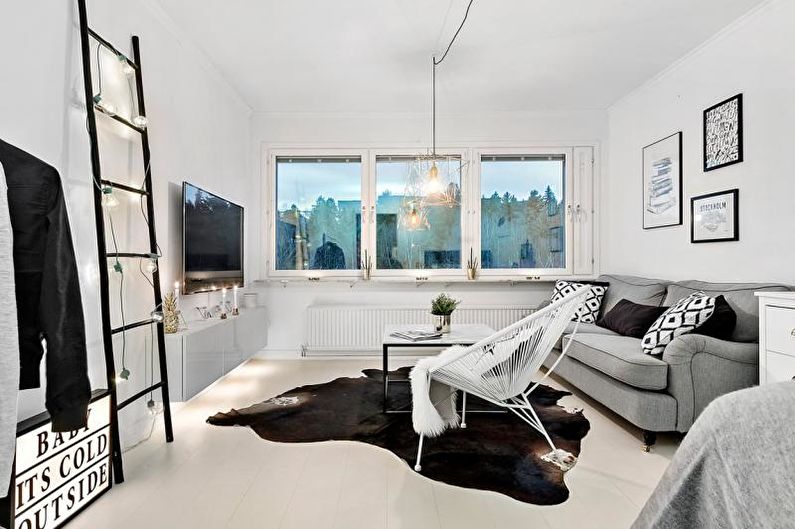
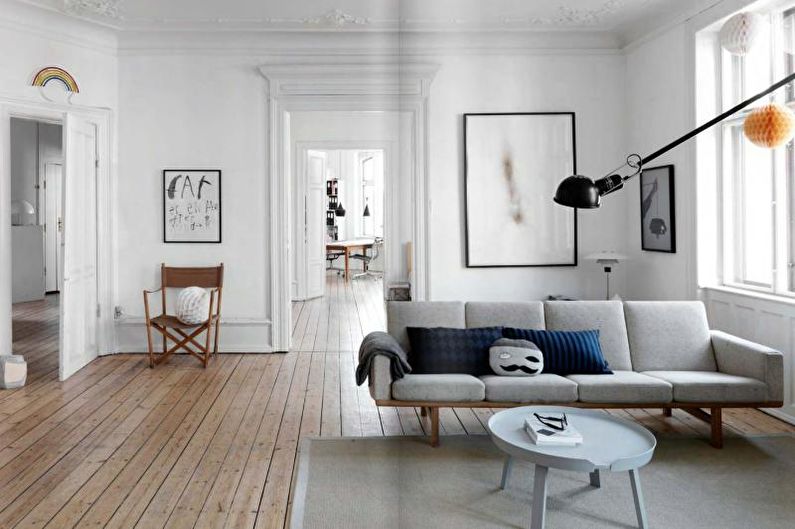







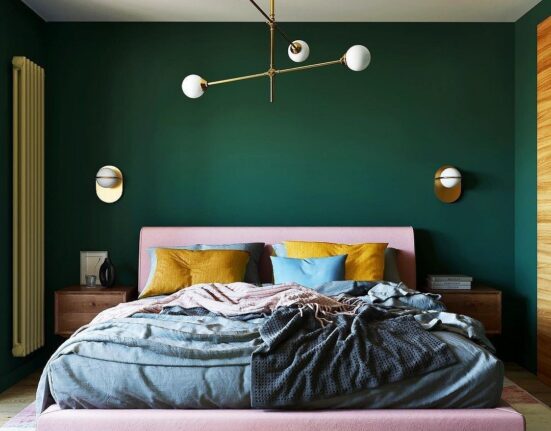

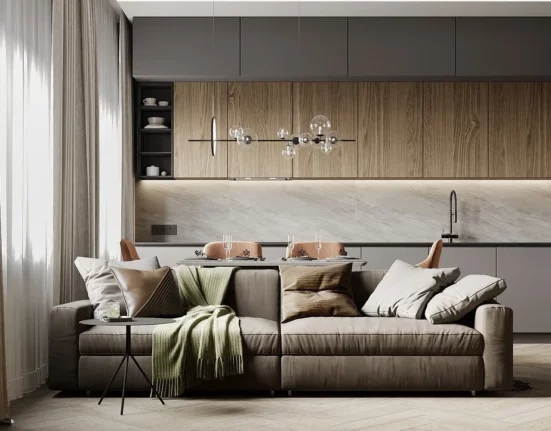
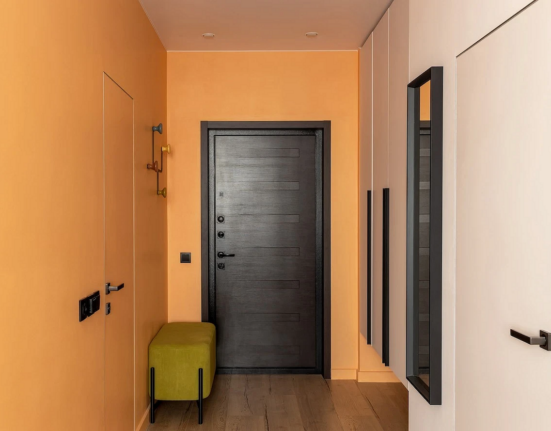

Leave feedback about this